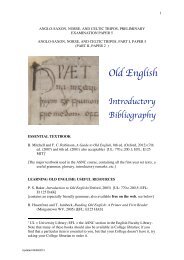Scandinavian history in the Viking age - Department of Anglo-Saxon ...
Scandinavian history in the Viking age - Department of Anglo-Saxon ...
Scandinavian history in the Viking age - Department of Anglo-Saxon ...
Create successful ePaper yourself
Turn your PDF publications into a flip-book with our unique Google optimized e-Paper software.
<strong>Scand<strong>in</strong>avian</strong> History <strong>in</strong> <strong>the</strong> Vik<strong>in</strong>g Age<br />
The evidence <strong>of</strong> place-names<br />
Place-names supply much useful <strong>in</strong>formation on pagan cults and society, <strong>in</strong> terms <strong>of</strong> ‘<strong>the</strong>ophoric’ names<br />
<strong>in</strong>dicat<strong>in</strong>g devotion to particular div<strong>in</strong>ities along with cultic elements such as h<strong>of</strong> or vé which can be used<br />
(with caution) to extrapolate practices <strong>of</strong> worship and beliefs. For broader surveys <strong>of</strong> place-name material<br />
see (B840 ff.).<br />
[K90] M. Olsen, Hedenske kultm<strong>in</strong>der i norske stedsnavne, SDNVAO 1914:4 [UL 500:01.b.4.18]<br />
[K91] Ó. Lárusson, ‘Hea<strong>the</strong>n and Christian traces <strong>in</strong> Icelandic place-names’, Proceed<strong>in</strong>gs and<br />
transactions <strong>of</strong> <strong>the</strong> third International Congress <strong>of</strong> Toponymy and Anthroponymy, Brussels, July 15th-<br />
July 19th 1949, edd. H. Draye and O. Jodogne (1951), 252-58 [UL P498.c.20.5]<br />
[K92] B. Holmberg, ‘Views on cultic place-names <strong>in</strong> Denmark: a review <strong>of</strong> research’, (O60):381-93<br />
[K93] S. Br<strong>in</strong>k, ‘Cult sites <strong>in</strong> nor<strong>the</strong>rn Sweden’, (O60):458-89<br />
[K94] T. Andersson, ‘Orts- und Personennamen als Auss<strong>age</strong>quelle für die alt-germanische Religion’,<br />
(K12):508-40<br />
[K95] S. Sigmundsson, ‘Átrúnaðr og örnefni’, (B261):241-54 (E.s.)<br />
[K96] B. Holmberg, ‘Recent research <strong>in</strong>to sacral names’, (A51):280-87<br />
Festivals and worship<br />
Place-names give <strong>the</strong> impression <strong>of</strong> widely disparate cults across Scand<strong>in</strong>avia. Although it should be<br />
borne <strong>in</strong> m<strong>in</strong>d that <strong>the</strong>ophoric place-names can conta<strong>in</strong> <strong>the</strong> names <strong>of</strong> different div<strong>in</strong>ities who may have<br />
performed similar functions <strong>in</strong> different regions, it is widely held that pagan beliefs and customs are<br />
likely to have varied widely <strong>in</strong> time and place.<br />
Cult-sites and social ga<strong>the</strong>r<strong>in</strong>gs<br />
One <strong>of</strong> <strong>the</strong> most visible, or at least easily reconstructed, forms <strong>of</strong> pagan worship is <strong>the</strong> communal<br />
ga<strong>the</strong>r<strong>in</strong>g at cult-sites, <strong>of</strong>ten go<strong>in</strong>g under <strong>the</strong> name h<strong>of</strong>. The frequent translation <strong>of</strong> this word as ‘temple’<br />
seems to be mislead<strong>in</strong>g, <strong>in</strong> that separate sacral build<strong>in</strong>gs are difficult to uncover <strong>in</strong> <strong>the</strong> material record;<br />
we seem <strong>in</strong>stead to be deal<strong>in</strong>g with ceremonial build<strong>in</strong>gs or halls which had many functions, <strong>in</strong>clud<strong>in</strong>g<br />
ritual ceremonies, cf. (C60 ff.). For a fasc<strong>in</strong>at<strong>in</strong>g recently excavated site, see:<br />
[K100] A.-L. Nielsen, ‘Pagan cultic and votive acts at Borg: an expression <strong>of</strong> <strong>the</strong> central significance <strong>of</strong><br />
<strong>the</strong> farmstead <strong>in</strong> <strong>the</strong> late Iron <strong>age</strong>’, (O80):373-92; on Borg <strong>in</strong> Östergötland<br />
[K101] S. Br<strong>in</strong>k, ‘Mythologiz<strong>in</strong>g landscape. Place and space <strong>of</strong> cult and myth’, (O84):76-112<br />
[K102] C. Raudvere et al., (edd.), Plats och Praxis: Studier av nordisk förkristen ritual (2002)<br />
The h<strong>of</strong>s <strong>of</strong> Iceland<br />
The ‘temples’ <strong>of</strong> Iceland were long held as prime examples <strong>of</strong> cultic build<strong>in</strong>gs <strong>in</strong> Scand<strong>in</strong>avia, but <strong>the</strong><br />
reliance <strong>of</strong> earlier scholars on accounts <strong>in</strong> sagas (K60 ff.) has now been tempered by more caution. For<br />
surveys <strong>of</strong> earlier scholarship see (K125) and (G22).<br />
[K103] B.S. Phillpotts, ‘Temple-adm<strong>in</strong>istration and chiefta<strong>in</strong>ship <strong>in</strong> pre-Christian Norway and Iceland’,<br />
SBVS 8 (1912-13), 264-84<br />
[K103] A. Roussell, ‘Islands gudehove’, (G15):215-23 (E.s. 322-23)<br />
[K104] A. Friðriksson and O. Véste<strong>in</strong>sson, ‘H<strong>of</strong>staðir revisited’, NAR 30 (1997), 103-12<br />
O<strong>the</strong>r famous cult-sites<br />
[K110] On Jell<strong>in</strong>g <strong>in</strong> Jutland see also (D60 ff.) and E. Dyggve, Three sanctuaries <strong>of</strong> Jell<strong>in</strong>g type, Scripta<br />
m<strong>in</strong>ora 1959-60:1 [UL P911:36.c.16.16]; Dyggve’s <strong>in</strong>terpretation is now dated, cf. (K125)<br />
[K111] For Lejre see (D31) and <strong>the</strong> account by Thietmar (B63)<br />
[K112] The seat <strong>of</strong> <strong>the</strong> earls <strong>of</strong> Lade or Hlaðir <strong>in</strong> <strong>the</strong> Trøndelag <strong>in</strong> central Norway may probably be<br />
considered a cultic centre; for saga-accounts, see K. Düwel, Das Opferfest von Lade: quellenkritische<br />
Untersuchungen zur germanischen Religionsgeschichte, Wiener Arbeiten zur germanischen<br />
Altertumskunde und Philologie 27 (1985) [UL 500:05.d.5.27]<br />
[K113] The nearby site at Mære <strong>in</strong> <strong>the</strong> Trøndelag is also recorded as a cult-centre, which may be borne<br />
out by excavations under <strong>the</strong> mediaeval church, see H.-E. Lidén, ‘From pagan sanctuary to Christian<br />
church: <strong>the</strong> excavation <strong>of</strong> Mære church <strong>in</strong> Trøndelag’, NAR 2 (1969), 3-32, and cf. (K125 ff.)<br />
109






